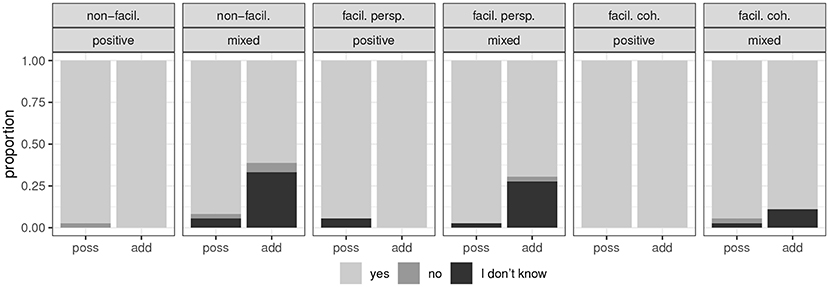Presupposition Accommodation of the German Additive Particle auch (= “too”)
- Linguistics Department, University of Potsdam, Potsdam, Germany
Presupposition triggers differ with respect to whether their presupposition is easily accommodatable. The presupposition of focus-sensitive additive particles like also or too is often classified as hard to accommodate, i.e., these triggers are infelicitous if their presupposition is not entailed by the immediate linguistic or non-linguistic context. We tested two competing accounts for the German additive particle auch concerning this requirement: First, that it requires a focus alternative to the whole proposition to be salient, and second, that it merely requires an alternative to the focused constituent (e.g., an individual) to be salient. We conducted two experiments involving felicity judgments as well as questions asking for the truth of the presupposition to be accommodated. Our results suggest that the latter account is too weak: mere previous mention of a potential alternative to the focused constituent is not enough to license the use of auch. However, our results also suggest that the former account is too strong: when an alternative of the focused constituent is prementioned and certain other accommodation-enhancing factors are present, the context does not have to entail the presupposed proposition. We tested the following two potentially accommodation-enhancing factors: First, whether the discourse can be construed to be from the perspective of the individual that the presupposition is about, and second, whether the presupposition is needed to establish coherence between the host sentence of the additive particle and the preceding context. The factor coherence was found to play a significant role. Our results thus corroborate the results of other researchers showing that discourse participants go to great lengths in order to identify a potential presupposition to accommodate, and we contribute to these results by showing that coherence is one of the factors that enhance accommodation.
1. Introduction
Additive particles belong to the class of alternative-sensitive particles, i.e., they interact with alternatives. For example, the presupposition contributed by also in (1) changes depending on the location of focus (Rooth, 1996, p. 272), which is marked by prosodic prominence in English (indicated by small caps): In (1a), also contributes the presupposition that John introduced somebody else to Sue, whereas in (1b) John introduced Bill to somebody else.

In an Alternative Semantics account, focus is assumed to indicate salient alternatives (Rooth, 1985, 1992, 1996, i.a.). Apart from their ordinary semantic value, all expressions also have a focus value (indicated by the superscript f in (2ac)). The focus value of the focused constituent is a set of alternatives of the same type as the denotation of the focused constituent (2a). For out-of-focus constituents, the focus value is a set containing only the denotation of the constituent itself (2b). Focus values can be composed via pointwise functional application to derive the focus value of the whole proposition (2c), a set of propositions which differ only in that the focused constituent is replaced by its alternatives.

Kripke (2009) proposed that additive particles as in (1) do not merely contribute an existential presupposition (“one of the propositional focus alternatives is true”), but give rise to an anaphoric presupposition amounting to the requirement that one of the propositional focus alternatives is prementioned. For example, in (3), the first sentence entails that John is afraid of something/somebody. This information is not enough to license the use of also, which seems to require that the context specifies who exactly the other individual that John is afraid of is.

In the literature, two main accounts of the anaphoricity of additive particles are prevalent: According to the first account, a propositional alternative has to be prementioned or entailed by the immediately preceding context (Asher and Lascarides, 1998; Beaver and Zeevat, 2007; Roberts, 2010; Tonhauser et al., 2013, i.a). We will call this account the SALIENT PROPOSITION account. A formal proposal of this can be found in (4) (from Chemla and Schlenker, 2012, p. 190): too requires that a proposition is salient which is (i) true in the evaluation world w, and which (ii) contextually entails one of the focus alternatives of the proposition which is logically independent of the proposition itself1.
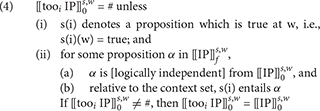
An account making the same predictions but for different reasons is that of Ruys (2015): He proposes that additive particles in fact merely contribute an existential presupposition that one of the other focus alternatives needs to be true (5). The anaphoricity is due to the fact that too is focus-sensitive and that focus is anaphoric (though Ruys formalizes this in terms of Givenness; see Schwarzschild 1999). The combination of focus anaphoricity and existential presupposition explains why too is licit in a subset of possible focus contexts, namely only those in which another alternative is previously entailed to be true.

The second main account of anaphoricity is one which suggests that additive particles merely require the salience of a focus alternative of the focused constituent (Corblin, 1991; Heim, 1992; Geurts and van der Sandt, 2004). Since in most examples, this is an individual, we will call this the SALIENT INDIVIDUAL account. (6) is the variant of this account proposed by Heim (1992). In this case, the presupposition involves an individual pronoun xi which requires an antecedent in the immediately preceding context. This individual pronoun is responsible for the anaphoricity of too and other additive particles.

A further variant of this account is that of Geurts and van der Sandt (2004), who propose that sentence (7) actually has two presuppositions, (7a) and (7b)2 (Geurts and van der Sandt, 2004, p. 31).

They propose that the first presupposition is hard to accommodate because it is poor in descriptive content, whereas the second presupposition can be accommodated. The underlying assumption is that the reason why some presuppositions are hard to accommodate whereas others are easy to accommodate is that the former lack a rich descriptive content—the hearer thus doesn't have enough information to know what exactly to accommodate (van der Sandt, 1992).
We test these two accounts of the anaphoricity of additive particles in two experimental studies using semantic judgments and questions targeting the presupposition, following up on a previous study in Grubic (forthcoming). This paper is structured as follows. First, we discuss experimental work on presupposition accommodation in section 2. Thereby, section 2.1 introduces the topic and shows that the German triggers discussed here behave the same as their English counterparts. Section 2.2 discusses experimental work on the accommodation of the presupposition of additive particles. These studies find that participants are willing to reinterpret the test sentences or accommodate that something in the context is the required antecedent, in order to assure that the presupposition is satisfied in the context. There are only few studies which would allow us to decide between the accounts mentioned above, and they do not investigate which further factors play a role for accommodation. Section 2.3 discusses a previous experiment by the first author on the presupposition of German auch (= “too”). The results seemed, on first glance, to confirm the predictions of the SALIENT INDIVIDUAL account, but additive particles in neutral contexts (i.e., where neither of the presuppositions proposed by Geurts and van der Sandt for additive particles are satisfied) received unexpectedly high felicity ratings. Section 3 reports two new follow-up experiments that we conducted. The first experiment, discussed in section 3.1, improves the methodology and stimuli, and controls for two different kinds of possible confounds: (i) whether the presupposition of auch, when accommodated, enhances coherence, and (ii) whether the context is from the point of view of the individual that the presupposition is about. The results show that at least one of these factors, namely coherence, facilitates accommodation. However, the experiment retained the problem that auch was judged to be quite acceptable in neutral contexts. For this reason, two changes were made to the materials in the second experiment, discussed in section 3.2, to see whether this has any influence on the felicity of auch in neutral contexts. First, to see whether participants correctly identify the associate of auch, a third type of test sentence was added in which auch unambiguously associates with the subject. A similar pattern was found for the unambiguous version, showing that this was not the problem. Second, items in which the presupposition was something very frequent or likely were changed, in order to see whether likelihood of the presupposition plays a role. The result patterns in the second experiment were indeed clearer, arguably due to the elimination of this potential confound. Again we find an effect of coherence, and find that in contexts without any potentially accommodation-enhancing factors, the results look as predicted by the SALIENT PROPOSITION account.
2. Background
2.1. Presupposition Accommodation
Presupposition triggers differ with respect to the ease with which their presupposition can be accommodated, i.e., how felicitous the utterance is when the presupposition is new to the addressee. For example, the presupposition of the possessive construction is easy to accommodate, while those of additive particles and pronouns like he are not easily accommodatable (e.g., Beaver and Zeevat, 2007). Since the German equivalents of these three triggers will play a role in our experiments, this is demonstrated here for them by checking whether the respective trigger is infelicitous in a neutral context, a context that doesn't entail the presupposition, in contrast to a minimally different positive context which does entail the presupposition (test and examples taken from Tonhauser et al., 2013). These sentences were tested as part of our fillers in both experiments, and, as expected, the sentences (a) in which the context does not entail the presupposition were rated felicitous in (8) (with a mean rating of 4.12 on a 5-point scale3), but substantially worse in (9)–(10) (mean rating: 2.16/2.79, respectively). All sentences were judged to be felicitous in the minimally different contexts in (b) entailing the presupposition (with mean ratings of 4.74/4.00/4.82, respectively, on a 5-point scale).
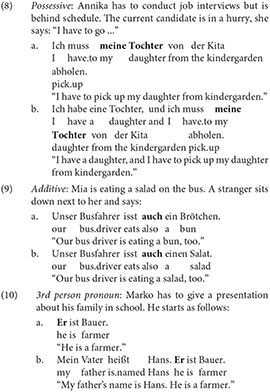
In the following, the previous experimental literature on additive particles and presupposition accommodation is discussed, before introducing our own experiments, in which we compare additive particles to possessives with a third person pronoun possessor.
2.2. Accommodation and Additive Particles
Often, experiments on the accommodatability of the presupposition of additive particles have focused on whether some other linguistic material provided in the discourse can be interpreted as the required antecedent. For example, Singh et al. (2016) test sentences like the four possible variants of (11). They propose that if the presupposition of too (here “John went swimming”) is made very plausible by the assertion that he went to the pool, accommodation is possible (acceptability was 94%), whereas when it is made implausible by the assertion that he went to the mall, the sentences are less acceptable (40%)4.

Schwarz (2007) investigates whether in German sentences with ambiguous relative clauses (subject vs. object relative clause readings), the syntactically dispreferred object relative clause reading is more readily available when it helps make sense of an additive particle. For example, the additive particle in (12) requires an antecedent entailing that somebody else saw the woman. This is satisfied in (12) under its object relative clause reading (“The woman that the girl saw had been seen by the man, too”), but not under its subject relative clause reading (“The woman that saw the girl had been seen by the man, too”). He finds that in order to find suitable antecedents for auch (= “also/too”), German native speakers can override syntactic processing preferences.

Chemla and Schlenker (2012) investigate whether in sentences like (13), participants conclude that it is reasonable for Anne to study abroad according to the speaker, i.e., that the presupposition of aussi (“Anne makes a reasonable decision”) is contextually entailed by the overt antecedent (“Anne decides to study abroad”). This was tested for a variety of different complex sentences, including ones where the “antecedent” followed the host sentence of aussi.
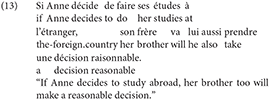
The results of these experiments suggest that hearers are willing to go to great lengths to find a suitable antecedent in the context. In particular, they suggest that hearers can, if it is plausible enough, accommodate that some preceding linguistic material is in fact the required antecedent. These experiments do not, however, test whether the presupposed proposition itself can be accommodated.
Out-of-the-blue, or with a preceding so-called neutral context—one that does not entail the presupposition—sentences with additive particles have been found to be degraded. For example, Tiemann (2014) tests sentences like (15) in the three kinds of contexts in (14). She reports a mean acceptability rating of 1.7 on a 4 point scale (1 = unacceptable, 4 = fully acceptable) for German auch in neutral contexts (Tiemann 2014, p. 76; see also Tiemann et al., 2011). The test sentences were judged significantly worse in negative contexts (mean acceptability: 1.3), and significantly better in positive contexts (3.7).
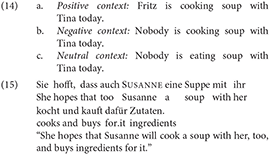
These results thus corroborate the claim that additive particles require their presuppositions to be entailed by the preceding context, i.e., that a presupposed proposition cannot be accommodated.
Note however, that there are other experimental results suggesting that when a subsentential focus alternative is in the preceding context, accommodation is possible, e.g., the eye-tracking experiments reported in Kim (2012, p. 64–84, 118–131) and Kim (2015, p. 120–128). For example, in (16), in order to make sense of the additive particle, the experiment participants were required to accommodate that Jane has some pears and some oranges, an inference that is not entailed by anything in the preceding context (Kim, 2012, p. 65). Participants were asked to pick a picture displaying what Jane has, (i) only apples, (ii) pears and oranges, (iii) pears, oranges and apples, or (iv) only oranges. Importantly, the participants were provided with the option of ignoring the presupposition by picking the picture containing only apples5. Kim's results indicate that the participants accommodate the presupposition (in about 80% of cases in the experiments for which she provides the response data), and her eye-movement data suggests that the presupposition is processed immediately as soon as the additive particle is heard.

A similar experiment is reported in Gotzner and Spalek (2014) for German auch (= “also”/“too”), compared to nur (= “only”) and focus. The context introduced two individuals (in (19), a judge and a witness), one of whom served as the focus in the target sentence. Participants were asked to judge the felicity of the short story on a scale from 1 (not at all acceptable) to 7 (very acceptable), and to judge the truth of a sentence with respect to the story, for example for (17) “the witness believed the defendant”. The type of accent on the focused constituent was manipulated, but did not yield a significant difference in the auch conditions.

There was no significant difference between the felicity ratings for the different conditions. The auch-sentences received a mean felicity rating of 5.7. Concerning the truth value judgments, the mean percentage of TRUE responses for the auch-conditions was around 74%. Both results suggest that accommodation of the presupposition of auch is possible. The felicity judgment results additionally suggest that if there is any additional cost of accommodation, it either does not effect felicity ratings or is masked by the fact that the other conditions also involved making additional inferences of some kind (presupposition accommodation with nur, conversational implicatures with the bare focus).
Note however that there are also experiments which are similar to the ones by Kim (2012, 2015) and Gotzner and Spalek (2014) and nevertheless report differences in accommodation between different triggers. Domaneschi et al. (2014) report the results of an experiment on Italian in which participants heard short stories, each containing several different kinds of presupposition triggers, among them additive particles. For additives, since the stories contained other individuals, accommodation is predicted by the SALIENT INDIVIDUAL account, but not the SALIENT PROPOSITION account. The participants then had to answer questions about the story, some of which tested whether the presuppositions were accommodated. They were distracted from this task by an additional memory task. Domaneschi et al. (2014) found that whereas with definite descriptions and factive verbs, presupposed information was accommodated and recalled in 87% and 88% of cases, respectively, this was only the case in 57/59% of cases for iteratives and additive particles (anche, pure (“also”), and persino (“even”), Domaneschi, p.c.). Thus, while the accommodation rate for additives was much higher than in Tiemann's experiment, it was still lower than for other presuppositions.
The contrast between the results of Tiemann (2014)'s experiment and the ones of Kim (2012, 2015), Gotzner and Spalek (2014), and Domaneschi et al. (2014) suggest that the SALIENT INDIVIDUAL account might be on the right track, since in the latter experiments, accommodation was possible to some extent even though no salient parallel proposition was entailed by the previous context. Instead, alternatives to the focused constituent were contextually available in these experiments. In Tiemann's experiment, neither was available, and accommodation thus not possible. Note however that Domaneschi et al. still find differences between different triggers, nevertheless, and that, as Beaver and Zeevat (2007) demonstrate with their example (18), not all environments which license pronouns also license an additive particle. While after Jane likes Bill, it is possible to refer back to Jane using the pronoun she, it is hard, according to Beaver and Zeevat, to accommodate that Jane is having dinner in New York. Further factors thus seem to play a role.

Thus, to sum up, there are up to now only few experiments testing the predictions of the SALIENT INDIVIDUAL/SALIENT PROPOSITION accounts, and none—to our knowledge—which test whether any further factors play a role. We report, in section 2.3, the result of a previous experiment in which accommodation of the additive presupposition seemed easier than expected, even in neutral contexts, and then, in the main part of this paper, we present and discuss our follow-up experiments in which we additionally manipulated the following factors: (i) whether accommodation enhances coherence, and (ii) whether or not the context is from the point of view of the individual that the presupposition is about.
2.3. Comparing Possessives and Additive Particles
In this section, we will summarize in some detail the results of an experiment by Grubic (forthcoming). Our new experiments that we will present in section 3 are designed as follow-ups to this study.
Grubic (forthcoming) compared the behavior of possessive pronouns and the additive particle auch in three different types of context. In the first one, called positive context, both potential presuppositions of the possessive/additive were explicitly satisfied by the context (1. that there is a salient individual, 2. that this individual has the relevant property). In the second type, the neutral context, neither of these presupposition was satisfied. In the third type of context, the mixed context, only one of the presuppositions (that there is a salient individual) was satisfied, but not the other (that the individual has the relevant property). Examples of the context types is given in (19). The target sentences are illustrated in (20).
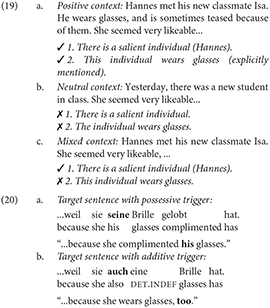
The participants' task was to rate the felicity of the items, and to answer a question that checked whether the second presupposition had indeed been accommodated. For example, after reading the mixed context in (19c) and the target sentence with an additive trigger in (20b), the participant was asked to judge whether the sentence makes sense in the context provided (“How good is the sentence in this context? Please rate it on a scale from 1 (not good at all) to 5 (very good)”), and to answer the question “Does Hannes wear glasses?” (Yes/No/I don't know).
Third-person possessive pronouns are particularly well suited as a baseline for the experiment because they involve presuppositions that are similar to those that the salient individual account predicts for additives. First, being third-person pronouns, they require a salient antecedent; e.g., in (20), seine Brille (“his glasses”) presupposes that there is a salient male individual. As discussed above in section 2.1, it is an uncontroversial assumption (which is also supported by the findings in our filler items) that this presupposition cannot be accommodated. Second, being possessives, they presuppose a possessive relation between that individual and their complement NP; e.g., in (20), seine Brille (“his glasses”) presupposes that the salient male individual has glasses. As discussed above in section 2.1, it is an uncontroversial assumption (again, supported by our filler items) that this presupposition can be accommodated very easily. Thus, possessive pronouns should receive low ratings in the neutral context, in which no suitable individual is made salient by the context. In the positive context, they should receive high ratings, because both presuppositions are satisfied by the context. In the mixed context, they should also receive high ratings, because the salient individual presupposition is satisfied, and the possessive relation can be easily accommodated.
As for additives, the predictions differ between the approaches discussed above. If it is correct that additives are similar to possessives in that the presence of a salient individual is sufficient and the relevant proposition can be accommodated, they should show the same pattern as possessive pronouns: they should also be acceptable in both the mixed and the positive context. TRIGGER TYPE (possessive vs. additive) should thus not interact with CONTEXT (mixed vs. positive/neutral). In addition, the proportion of yes-answers to the question asking whether the presupposition is fulfilled should be very high for both possessives and additives.
If, however, the relevant proposition needs to be explicitly expressed in the context, they should only be acceptable in the positive context. In that case, TRIGGER TYPE should interact with CONTEXT in the following direction: the felicity difference between the positive and the mixed context should be larger for additives than for possessives, and the difference between the neutral and the mixed context should be smaller for additives than for possessives. Concerning the answers to the content question, additives in the mixed context should give rise to a high proportion of “no” or “I don't know” answers, indicating that the presupposition cannot be accommodated. The predictions are illustrated in Figure 1.
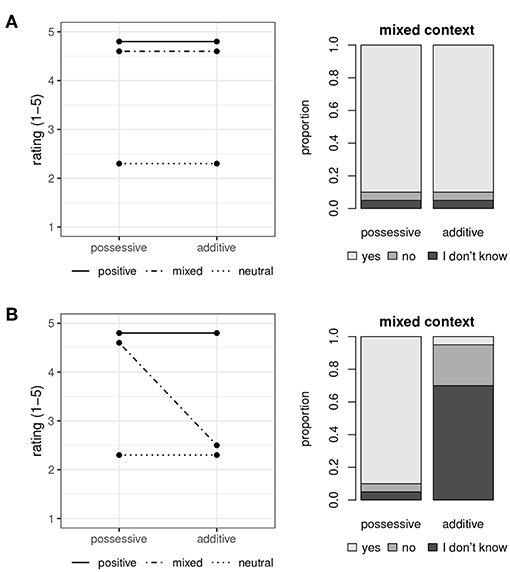
Figure 1. The SALIENT INDIVIDUAL account (A) predicts no interaction, but a significant difference between mixed/positive and neutral context. The SALIENT PROPOSITION account (B) predicts an interaction between TRIGGER TYPE (possessive/additive) and CONTEXT (mixed/positive/neutral).
The results are presented in Figure 2. The left plot shows felicity ratings on a 1–5 scale. The interaction between TRIGGER TYPE (possessive vs. additive) and CONTEXT was significant when comparing the mixed to the neutral context: the difference between the two contexts was smaller for additives than possessives. No significant interaction was found when comparing the mixed to the positive context (see Grubic forthcoming for statistical details). The right plot shows proportions of answers to the content question. They are only shown for the positive and mixed context here, in which the same question was asked (“Does Hannes wear glasses?” in (20a) and (20c))6.
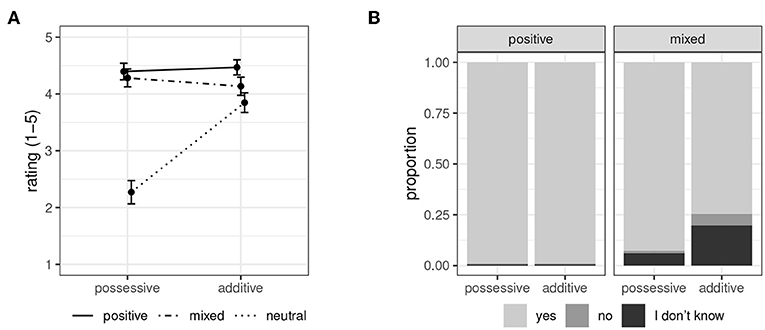
Figure 2. Results of the experiment reported in Grubic (forthcoming): felicity ratings with 95% confidence intervals (A) and answer proportions (B).
The results show that for additives, the felicity ratings in the mixed context are closer to the ratings in the neutral context than for possessives. However, this difference is mainly driven by an unexpected behavior of the additive particles in the neutral context: their ratings were much higher here than for possessives. Neither of the two approaches predicted this pattern. As for the answers to the content questions, they were almost always answered by “yes” in the positive context. In the mixed context, a higher proportion of “no” and “I don't know” answers was found, but a clear majority of trials was answered by “yes.” This suggests an overall high rate of accommodation, in line with the predictions of the SALIENT INDIVIDUAL account, which was however a bit lower for additives than for possessives.
3. Experiments
3.1. Experiment 1
3.1.1. Motivation
In Grubic (forthcoming)'s experiment discussed above, an interesting result was that one of the contexts that was intended as a negative baseline (the neutral context) did not show the expected results with the additive particle. Rather than rejecting sentences containing auch without a salient parallel proposition nor a salient individual in the context, participants rated them as highly acceptable.
We hypothesized that this might be due to the written modality of the experiment. Reading the target sentence with an implicit prosody that differed from the intended one could have altered the interpretation: instead of the intended association with the subject (which requires stress on the additive particle), participants might have read the sentences with stress on the object, leading to association of the additive particle with the object. In some of the items, this might result in a plausible reading in the neutral context, potentially increasing felicity.
We additionally changed some of the neutral contexts. It was noted in Grubic (forthcoming) that the neutral contexts in which the test sentences received the highest ratings often involved quantifiers, where the implicit restrictor of the quantifier might serve as an antecedent. For example, it seems relatively easy to accommodate, in (21), that the other guests have newspapers.

Furthermore, Grubic (forthcoming) observes that the materials of the original experiment varied with respect to the discourse-status of the individual whose property needed to be accommodated. In some of the items, that individual was the subject of the first sentence, which had the effect that the story seemed to be told from his or her point of view. They also varied with respect to the role that the accommodated proposition played in the discourse in which they were embedded. In some of them, as in (21), the presupposed meaning contribution of auch increases the coherence of the text. Without it, it might be unclear why glasses would make someone more or less likeable to Hannes. The meaning expressed by auch provides motivation for this—Hannes and the classmate have something in common. In other items, the presence of auch was not crucial for coherence in this way.
We agree with Grubic (forthcoming)'s reasoning that these properties might influence how easy it is for readers/listeners to identify which presupposition the author/speaker intended to convey (this will be discussed in more detail in section 4). We thus also aim to test the following hypothesis:

In other words, we hypothesize that it might be misleading to assess the predictions of the SALIENT INDIVIDUAL and the SALIENT PROPOSITION account based on average judgments across all materials; each account might each make correct predictions for a subpart of the data, depending on the properties of the discourse. Statistically, this would amount to a three-way interaction between TRIGGER TYPE, CONTEXT, and DISCOURSE TYPE. We will describe below in more detail how we controlled for discourse type in our materials.
Finally, great care was taken to ensure that the corresponding sentences without auch are entirely felicitous in the neutral context, i.e., that the context and test sentence always form a coherent text, in order to be certain that any infelicity found in these cases is actually due to the additive particle.
3.1.2. Design and Materials
Experiment 1 is based on Grubic (forthcoming)'s design and materials, but with some adjustments. The first difference is that we presented the materials auditorily in order to ensure that the participants correctly identify the associate of the additive particle. Details about the recordings will be provided below.
In our experiment 1, we manipulated the items more systematically with respect to the discourse factors mentioned above by including DISCOURSE TYPE as a between-item factor. The three discourse types are illustrated schematically in (23) and by the examples in (24)–(26). A comparison of the discourse types in (23a) and (23b) shows whether the point of view plays a role, whereas a comparison of the discourse types in (23a) and (23c) shows the influence of coherence. Only the mixed context is shown here, but just like in the written experiment, a positive and a neutral context were constructed as well. Note that the discourse type manipulation does not apply to the neutral context—there, accommodating the presupposition never increased the coherence of the text, and there was always only one individual from whose point of view the story could be construed. In the positive context, on the other hand, the presupposed information is already provided, so the discourse hypothesis does not predict an effect there, either. It specifically predicts an effect on only the mixed context.
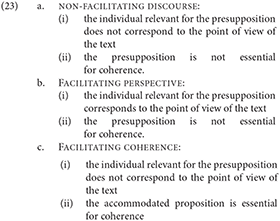
An example item of each type is shown below7. Sentence stress is marked by small caps.
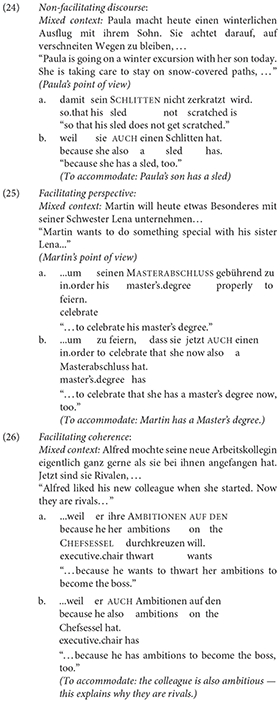
The stimuli were recorded by the first author of the paper with a prosodic realization that unambiguously signaled association of the focus-sensitive auch with the subject. This was achieved by assigning sentence stress to auch itself. Stressed auch associates with a preceding constituent. If several constituents are available, disambiguation is possible by marking one of them as a contrastive topic by a rising accent (Krifka, 1999). In our items, the only available constituent that the particle could associate with is the subject. Association with the direct object would require sentence stress on the object. In the conditions with a possessive pronoun, the object DP (e.g., ihre Ambitionen auf den Chefsessel “her ambitions to become the boss” in (26)) was deaccented in the positive context, in which it was explicitly mentioned in the preceding context, and accented in the neutral and mixed contexts, in which it was not prementioned.
3.1.3. Participants and Procedure
Thirty-six native speakers of German took part in the experiment. All of them were students at the University of Potsdam and received credit for participation.
The stimuli were presented using the online questionnaire software SoSci Survey (Leiner, 2018). On the first page, instructions were presented. On each following page of the questionnaire, an audio file was played automatically. At the same time, two questions appeared on the screen. First, the participants were asked to rate the last sentence of the text that they had heard on a scale from 1 (labeled as “very bad, does not make sense in this context”) to 5 (“very good, makes sense in the context”). The second task was to answer a question about the content of the text by choosing one of the options “yes,” “no,” or “I don't know.” As in Grubic (forthcoming)'s experiment, this question only targeted the presupposition of the additive particle in the mixed context. The same question was asked in the positive context, where the answer was already provided by the context. In the neutral context, a different question was asked. It was possible to listen to the audio file again if required (the number of replays was not limited). After answering the questions, the participants clicked a button to proceed to the next stimulus. The 18 items were distributed using a Latin Square design and randomized. There were six lists, resulting from crossing the factor TRIGGER TYPE (two levels: possessive vs. additive) with CONTEXT (three levels: mixed vs. neutral vs. positive). DISCOURSE TYPE was included as a between-item factor: six of the items involved a non-facilitating discourse, six involved facilitating perspective, and six involved facilitating coherence. Each participant rated 38 stimuli (two practice trials, 18 critical items and 18 fillers). This way, we obtained 36 data-points for each combination of TRIGGER TYPE/CONTEXT/DISCOURSE TYPE (one from each participant).
3.1.4. Results
The results (collapsing the three levels of the factor DISCOURSE TYPE) are presented in Figure 3.
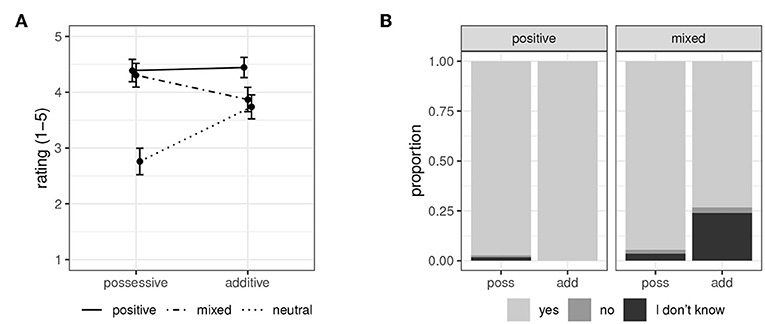
Figure 3. Results of experiment 1: felicity ratings with 95% confidence intervals (A) and answer proportions (B).
Figures 4, 5 show the results split by DISCOURSE TYPE.
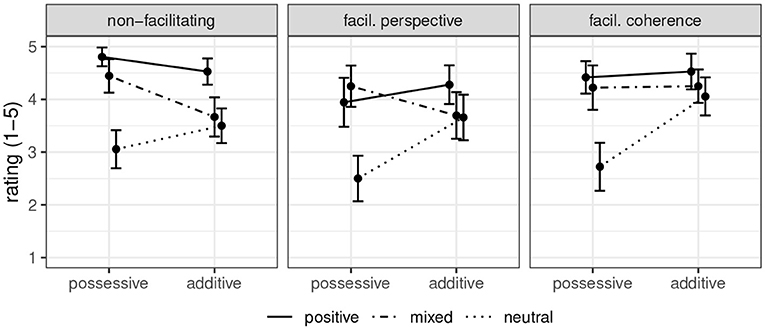
Figure 4. Felicity rating results of experiment 1 with 95% confidence intervals, split by discourse type.
For the statistical analysis, the factor TRIGGER TYPE (additive vs. possessive) was sum-coded. The factor CONTEXT was treatment-coded with the mixed context as the baseline, allowing to compare mixed vs. neutral and mixed vs. positive context. DISCOURSE TYPE was treatment-coded with the non-facilitating discourse as the baseline, allowing to compare non-facilitating vs. facilitating perspective and non-facilitating vs. facilitating coherence.
For distinguishing between the SALIENT PROPOSITION and the SALIENT INDIVIDUAL account with respect to the felicity ratings, it is crucial whether there is an interaction between TRIGGER TYPE and CONTEXT. According to a linear mixed model8, there was a significant interaction between these factors (mixed vs. neutral context: t = −3.89, p < 0.001).
For testing our DISCOURSE HYPOTHESIS, it is crucial to test whether there is an interaction between TRIGGER TYPE, CONTEXT, and DISCOURSE TYPE. No significant three-way interaction was found. The only significant interactions involving DISCOURSE TYPE were a two-way interaction with TRIGGER TYPE (non-facilitating vs. facilitating coherence: t = −2.56, p = 0.01) and a two-way interaction with CONTEXT (mixed vs. positive context, non-facilitating discourse vs. facilitating perspective: t = −2.12, p = 0.03).
Prior to our analysis of the responses to the question, we collapsed the “no” and “I don't know” answers to a single category (we interpret both answers as indicating non-accommodation of the target proposition). We only included the mixed context in the statistical analysis. In the positive context, the proportion of “yes” answers was at or close to 100%, making a meaningful statistical analysis difficult due to complete separation. In the neutral contexts, a different question was asked (unrelated to accommodation). The remaining factors (TRIGGER TYPE and DISCOURSE TYPE) were included as fixed factors in a logistic regression model. A significant effect of TRIGGER TYPE (z = 3.09, p = 0.002) and DISCOURSE TYPE (z = 2.09, p = 0.04) was found, but no significant interaction.
3.1.5. Discussion
The direction of the interactions between TRIGGER TYPE and CONTEXT is partially compatible with the predictions of the SALIENT PROPOSITION account: in the mixed context, additives are less acceptable than possessives (more precisely, the felicity difference between the mixed and the neutral context is smaller for additives than for possessives). However, as in Grubic's (forthcoming) original study, the interaction is driven by the high acceptability of additives in the neutral context rather than by low acceptability in the mixed context.
The results also show, and this is not predicted by the SALIENT PROPOSITION account, that DISCOURSE TYPE significantly affects the felicity of additives. The conditions including an additive are generally more acceptable (in comparison to possessives) in the facilitating coherence discourse type than in the non-facilitating discourse type, even though the proposition to be accommodated is still not entailed by the context, but instead merely becomes easier to identify because it enhances the coherence between the context and the test sentence. Note however, that although DISCOURSE TYPE should only have an effect in mixed contexts, the judgments of additives in the neutral context were also enhanced. This is unexpected because the intended facilitating perspective/coherence was not present in the neutral context. Thus, our DISCOURSE HYPOTHESIS (predicting more specific effects for the different context rather than an overall facilitation) was not confirmed.
Since DISCOURSE TYPE was a between-items factor in our design, it is possible that another aspect in which the items differed lead to the differences in the neutral context; we will address this possibility in the second experiment.
Our conjecture that the high ratings in the neutral context might arise because participants assign a different implicit prosody than intended was not confirmed: change of modality from written to auditory stimuli did not change this. However, it is conceivable that participants did not pay attention to the prosody in the items. In order to be certain that the associate of the additive particle was identified correctly by the participants, we took further measures in Experiment 2 (reported in the next section) to rule out any misinterpretation of the test sentences.
A second result not predicted by the SALIENT PROPOSITION account is that, like in the experiment reported by Grubic (forthcoming), the proportion of “yes” answers to the content question was higher for possessives than for additives, but for both trigger types, the “no”/“I don't know” answers are clearly in the minority. This suggests that most participants accommodated the target proposition in the mixed context. Numerically, there is a trend toward more accommodation in the facilitating coherence discourse type.
Based on Experiment 1, we tentatively conclude that the SALIENT PROPOSITION account, predicting that additives are only licit when the presupposition is entailed by the context, is too strong—at least in facilitating discourse types, the additive particle is acceptable to a similar degree in the mixed context as in the positive context. The SALIENT INDIVIDUAL account, predicting that additives should be felicitous whenever there is another salient individual, is too weak—in the absence of facilitating discourse factors, the acceptability of the additive particle is similarly low in the mixed context as in the neutral context. However, conclusive assessment of the accounts is impeded by the unpredicted behavior of additives in the neutral context.
3.2. Experiment 2
3.2.1. Motivation
In Experiment 1 discussed above, the result that additive particles were judged to be felicitous in a context that does not support their presupposition, which was already found in the experiment reported in Grubic (forthcoming), was corroborated. This is unpredicted considering the previous literature, which states that the presupposition of additive particles is hard to accommodate.
Assuming that the presupposition of additive particles is not in fact freely accommodatable, there are two possible explanations for this result. First, even though in the auditory stimuli main stress was placed on the additive particle, indicating association with the subject, the participants might not have paid ample attention to the intonation. Since the word order also allows for association of auch with the VP, this would lead to a presupposition that the subject of the sentence has some other property, which is satisfied in most if not all or our neutral contexts, and would explain the high felicity judgments. For example, in (27), the context entails that Jakob has several properties (being a student, talking to Klara), so the presupposition that he has a further property apart from having a sister is satisfied in this context.

A second possible explanation was that the possessum, e.g., a sister in (27), was usually something which generally a lot of people have (e.g., a sister, a car, a TV, i.a.). It is a central claim of the literature on the anaphoricity of too that world knowledge indicating that many people have the property in question does not license the use of the additive particle. For example, in Kripke's example (28), the knowledge that a lot of people are having dinner in New York on any given night does not, according to Kripke, make too felicitous (Kripke, 2009, p. 373). Nevertheless, we wanted to follow up on the hypothesis that the participants accommodate something of this sort, e.g., in example (27) that many other people have sisters.

Since this factor was not controlled for systematically in Experiment 1, it might also have lead to differences between the items, and, as a consequence, confounded the between-items factor DISCOURSE TYPE.
3.2.2. Design and Materials
The design and materials for Experiment 2 were based on Experiment 1, but the following three changes were made: first, all direct objects referring to something that people commonly have were replaced by more specific expressions, referring to something that most people do not have, but is nevertheless relatively uncontroversial9. For example, an object like sister was replaced by the more specific twin sister, as illustrated in (29).
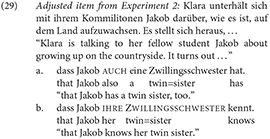
The second change was the addition of a third type of test sentence. In order to exclude the possibility that participants interpreted the additive particle as associating with something other than the subject (in spite of the prosodic cues), we tested a further type of structure in which the interpretation is made unambiguous by both prosody and syntax. In a sentence like (30), the additive particle can only associate with the subject it precedes.

The third change was made to the follow-up questions in the neutral context. In Experiment 1, these follow-up questions were about the assertion of the test sentence (e.g., “Does Jakob have a sister?”) in the neutral context and thus did not help decide whether participants accommodate the correct additive presupposition. The questions for the neutral context were thus changed in Experiment 2, so that they target the presupposition instead (e.g., “Does somebody else have a twin sister?”).
3.2.3. Participants and Procedure
Fifty-four native speakers of German took part in the experiment (resulting in the same number of data points per condition as for Experiment 1). Participants were recruited via Prolific. The stimuli were presented using the online questionnaire software L-Rex (Starschenko, 2018). The procedure was the same as described for experiment 1. Again, each participant rated 38 stimuli (two practice trials, 18 critical items and 18 fillers).
3.2.4. Results
The results are presented in Figures 6–8. Figure 6 (again collapsing the three levels of DISCOURSE TYPE) presents the mean felicity ratings and the answer proportions.
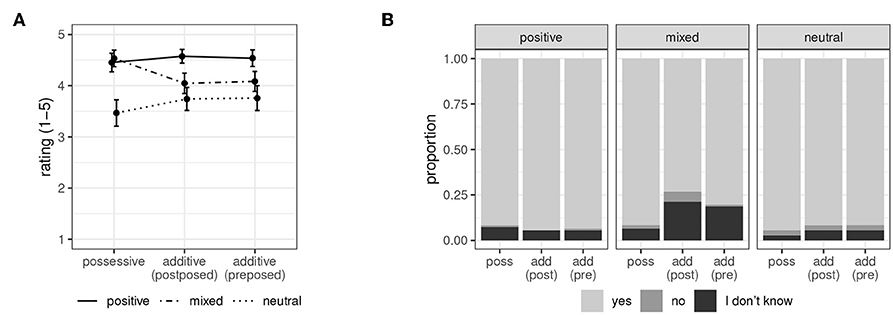
Figure 6. Results of Experiment 2: felicity ratings with 95% confidence intervals (A) and answer proportions (B).
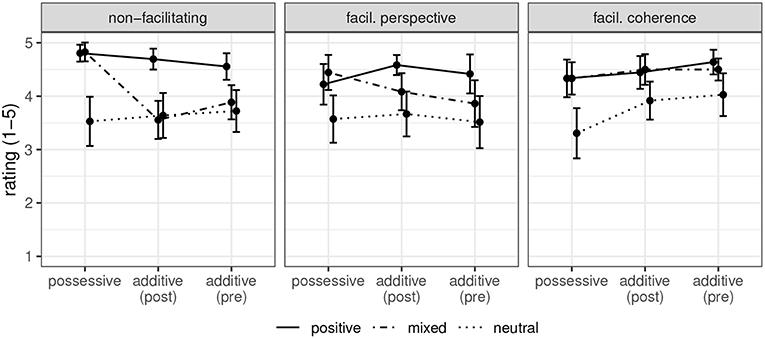
Figure 7. Felicity rating results of Experiment 2 with 95% confidence intervals, split by discourse type.
The results for the three different discourse types are presented in Figures 7, 8.
For the statistical analysis, the factors CONTEXT and DISCOURSE TYPE were again treatment-coded, as described for Experiment 1. The factor TRIGGER TYPE was Helmert-coded to allow comparison between additive (preposed/postposed) vs. possessive, and additive preposed vs. additive postposed.
With respect to the felicity ratings, according to a linear mixed model the factor TRIGGER TYPE (additive vs. possessive) interacted significantly with CONTEXT (mixed vs. positive context: t = −3.82, p < 0.001, mixed vs. neutral context: t = −4.81, p < 0.001), as in Experiment 1.
However, in contrast to the first experiment, this two-way interaction was qualified by higher-order interactions with DISCOURSE TYPE. The DISCOURSE HYPOTHESIS states that the strength of the TRIGGER TYPE (additive vs. possessive) × CONTEXT interaction differs depending on DISCOURSE TYPE; but it does not specify which levels of CONTEXT and DISCOURSE TYPE should be affected (because it was not possible to derive more specific hypotheses from the previously available data). There are therefore four possible interaction terms that would lend support to the discourse hypothesis if they were significant. We correct for the higher probability of Type I error in multiple testing using the Holm-Bonferroni method. The interaction with the lowest unadjusted p-value (additive vs. possessive; mixed vs. positive context; non-facilitating vs. facilitating coherence: t = 2.59, p = 0.0097) was significant at the adjusted α level of 0.0125; the others were not10.
Only one marginally significant difference was found between pre-posed and post-posed auch in form of an interaction with discourse type (non-facilitating vs. facilitating perspective: t = −1.89, p = 0.059).
Again, the “no” and “I don't know” responses were collapsed for the statistical analysis, and only the mixed context was included. TRIGGER TYPE (additive vs. possessive) interacted significantly with DISCOURSE TYPE (non-facilitating vs. facilitating coherence: t = −2.65, p = 0.008). A marginally significant overall difference between pre-posed and post-posed auch was found (t = 1.89, 0.059).
3.2.5. Discussion
One of the motivations for this experiment was to test whether participants misinterpreted the additive test sentences in Experiment 1 by choosing the wrong associate for postposed auch.
The felicity rating results indicate that there was little or no such misinterpretation: only marginally significant differences between postposed auch and preposed auch (which unambiguously associates with the subject in our test sentences) were found, and the crucial observations with respect to the felicity ratings—that the mixed context is closer to the neutral context for additives, and closer to the positive context for possessives—hold for both versions of auch. Nevertheless, the trend toward less “yes” and more “I don't know” answers for postposed auch than for preposed auch, especially in the non-facilitating discourse type, could be tentatively interpreted as an indication that participants felt more certain about the accommodated presuppostion when the associate for auch was marked syntactically, not only prosodically, and that it would therefore be advisable to use preposed auch in future research.
Generally, the results of Experiment 1 were replicated. First, an interaction between TRIGGER TYPE and CONTEXT was found, as predicted by the SALIENT PROPOSITION account (the mixed context is closer to the neutral one for additives than for possessives, and closer to the positive context for possessives than for additives), but not the SALIENT INDIVIDUAL account.
But again, as not predicted by the SALIENT PROPOSITION account, DISCOURSE TYPE was found to play a role for the felicity judgments. Like in experiment 1, the facilitating coherence discourse type again raised the ratings of the items with additives. But in contrast to Experiment 1, this did not affect the mixed and neutral context in the same way: it specifically raised the felicity of additives in the mixed context (as evidenced by the three-way interaction). While in the non-facilitating discourse type, the felicity ratings of the additive particles in the mixed context are very close to the negative baseline, they are very close to the positive baseline in the facilitating coherence discourse type. The fact that discourse type had a more specific effect in Experiment 2 rather than generally raising the acceptability (even in the neutral context) could be due to our effort to make the items more uniform with respect to how common the relevant objects were; this might have eliminated a confound and therefore reduced some of the random noise between items (and thus, crucially, between the discourse types).
When we compare the results to the predictions that were presented in Figure 1, it is particularly striking that the pattern in the non-facilitating discourse type corresponds almost exactly to the predictions of the SALIENT PROPOSITION account, whereas the pattern in the facilitating coherence discourse type is similar to the predictions of the SALIENT INDIVIDUAL account11 (except for the fact that the ratings in the neutral context are still somewhat higher for additives than for possessives). Thus, the tension between the two accounts might be resolved by taking into account discourse properties which can facilitate the identification of the proposition that needs to be accommodated.
In sum, these findings further support the view that a salient individual is not sufficient to make the use of the additive particle felicitous. A salient proposition, on the other hand, is not a necessary condition for felicity, at least in the sense that it does not necessarily need to be present in the immediately preceding context. Accommodation is possible and facilitated by discourse factors. In the facilitating coherence discourse type, an additive can be as felicitous in the mixed context as in the positive context.
Although controlling the commonness/frequency of the possessum more systematically in Experiment 2 indeed helped to reduce some of the noise in the data and to make possessives and additives more comparable in the neutral context, our hypothesis that the surprisingly high felicity ratings for additive particles in this context might be due to this factor was not fully confirmed. What we observe is an increase in the felicity of the possessives, not a decrease in the felicity of the additives in comparison to Experiment 1. Inspection of the fillers suggests that this is not due to a scale bias, i.e., generally lower ratings by the participants of Experiment 2: on average, the fillers were rated a little bit higher than in Experiment 1 (3.86 vs. 3.66), but not to an extent that could fully explain the difference in the felicity of the possessives in the neutral context between the experiments. It is an open question whether this was caused by the choice of more specific objects, and if so, why it affected the felicity of the possessives in this way. We do however have some hypotheses as to why, in our experiments, additive particles received substantially higher felicity ratings in neutral contexts than in Tiemann (2014)'s experiment (e.g., (30)) and than our own filler item (9) (repeated here as (31)).
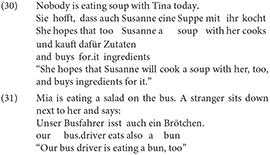
We believe that part of the reason is, first, that we took great care to ensure that the discourse is entirely natural and coherent without the particle, so that any infelicity stems from additive particle itself. Second, our neutral contexts did not contain any propositions that are similar to a potential antecedent. We hypothesize that (31) might be particularly infelicitous because the participants try to accommodate Mia is eating a salad as the required antecedent for our busdriver is eating a bun, and fail.
As a final methodological remark about our experiments, we would like to point out that our data shows a correlation between whether the answer to the content question indicated accommodation and the felicity rating12. This provides support for the view that felicity judgments can be used to investigate presupposition accommodation: when a presupposition cannot be accommodated, the test sentence receives a lower felicity rating.
4. Conclusion
4.1. Summary
This paper reports the results of two experiments aiming to test the salience requirements of the German additive particle auch. We tested the predictions made by the two main accounts on the anaphoricity of additive particles found in the literature: the SALIENT INDIVIDUAL account, which predicts that auch just requires a focus alternative to the focused constituent to be salient, and the SALIENT PROPOSITION account, which predicts that the context needs to entail a focus alternative to the entire proposition containing auch. Sentences with auch were thus tested in three different contexts: ones which entailed the proposition (positive context), ones which merely made an individual salient (mixed context), and ones which neither made a proposition nor an individual salient (neutral context).
Our results suggest that the predictions of the SALIENT INDIVIDUAL account (e.g., Heim, 1992; Geurts and van der Sandt, 2004) are too weak: when controlling for independent accommodation-enhancing factors like perspective and coherence, the existence of a salient individual in the context was not enough to make auch felicitous. However, our results also suggest that a strict version of the SALIENT PROPOSITION account is too strong: when the context does not entail the proposition, but enhances the probability that a certain prementioned individual is in fact the one relevant for the presupposition, auch becomes more felicitous. Two such accommodation-enhancing discourse types were tested: (i) when the preceding discourse can be seen to be from the point of view of the individual that the presupposition is about (perspective), and (ii) when the presupposition makes the text more coherent (coherence). Our experiments provide evidence for a significant effect of coherence (found for the judgments in Experiments 1 and 2, and for the proportion of answers indicating successful accommodation in Experiment 2). In the facilitating coherence discourse type, auch was judged to be as felicitous in the mixed context as in the positive context, and the proposition was indicated to be true to almost the same extent in the two types of contexts. These results thus clearly provide evidence against a SALIENT PROPOSITION account which requires that the proposition be entailed by the immediate linguistic or non-linguistic context (e.g., Ruys's 2015 Givenness account). Concerning other variants of the SALIENT PROPOSITION account, it depends on how exactly they define salience. As indicated by previous experimental findings (see section 2.1), hearers use previous linguistic material in order to identify the correct propositional focus alternative relevant for the presupposition. In the facilitating coherence cases, the relevant propositional focus alternative can be identified not because it is prementioned, but because that particular information makes the text coherent. For example, in (25), repeated here, the presupposed information (“Alfred's colleague has ambitions to become the boss”) makes the causal relationship between the main clause (“Alfred and his colleague are rivals”) and the embedded clause (“because Alfred has ambitions to become the boss”) more coherent, based on a previous assumption that in order to be rivals, two people have to have a common ambition13.
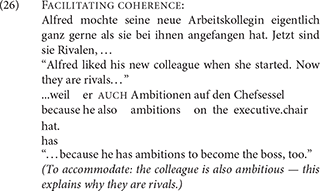
In order to account for these data, the relevant notion of salience would thus have to be one that also applies to inferences arising from the utterance itself, together with its context.
4.2. Accommodatability: The Bigger Picture
In this section, we briefly discuss the question whether our results have a bearing on the question what differentiates easily accommodatable from less easily accommodatable presuppositions. In the previous literature, three main reasons are proposed why certain triggers have presuppositions that are hard to accommodate: First, it has been proposed that these triggers presuppose that something is “in the discourse record” (see e.g., the proposal in Beaver and Zeevat, 2007, for too), i.e., immediately prementioned or mutually attended to and thus, according to Beaver and Zeevat, not accommodatable, see (32).

Second, some authors have suggested that presuppositions which are not crucially important for the truth-conditional meaning of the sentence can be ignored, see (33) (Tiemann 2014; Tiemann et al. 2015, cf. also Zeevat, 2002 and Jäger and Blutner, 2003's “Do Not Accommodate,” as discussed in Beaver and Zeevat, 2007)14. For additive particles the truth-conditional meaning of the sentence is simply the meaning of the sentence without the particle, the additive presupposition is thus not needed for the truth conditions and can be ignored according to (33).

Third, as noted above, van der Sandt (1992) and Geurts and van der Sandt (2004) propose that presupposition triggers that are not sufficiently semantically rich cannot be accommodated because the addressee cannot identify the presupposition to be accommodated. Beaver and Zeevat (2007) formulate this as in (34).

Even though, on the surface, additive particles give rise to a presupposition that appears to be rich in content, Geurts and van der Sandt (2004)—as noted above—assume that they involve two presuppositions, of which one is similar to a pronoun and thus descriptively poor and not accommodatable.
Our results do not support any hypothesis which strictly differentiates between two categories of triggers, on the basis of some part of their presupposition which is (un)accommodatable (e.g., the DISCOURSE RECORD PRINCIPLE and a strict understanding of the INSUFFICIENT CONTENT PRINCIPLE). In addition, we do not believe that MINIMIZE ACCOMMODATION properly explains the difference found here. It is true that in the facilitating coherence case, the presupposition is—in a sense—more relevant for the truth conditions because it is needed to establish coherence. However, MINIMIZE ACCOMMODATION does not account for the surprising level of acceptability that we find with auch sentences in general, nor does it, in our view, give credit to the effort that addressees make to identify a proposition which they can accommodate as the presupposition of auch. We suggest, instead, that our results support an account of identifiability (a weak version of the INSUFFICIENT CONTENT PRINCIPLE), which might be formulated as in (35)15.

In the case of auch, the individual relevant for the presupposition has to be identified, while the remainder of the presupposition can be deduced from the utterance containing the additive particle. Our results showed that while previous mention of an individual was not sufficient in order to allow for accommodation, a further indication that this individual is in fact the required focus alternative facilitated the accommodation of the additive presupposition. Further evidence comes from examples where the alternative set only contains two relevant alternatives, e.g., (36)16. There, no special context is needed in order to license the use of too, since the identity of the other alternative, being the only other focus alternative in the alternative set, is already clear.

Thus, while we hypothesize that coherence can generally be used to help identify the information to be accommodated (not only in the case of additive particles), there are other mechanisms, such as the role of a restricted alternative set as in (36), which are limited to focus-sensitive particles17.
4.3. Outlook: auch in Neutral Contexts
One result of our experiments was that, just like in Grubic's (forthcoming) experiment, additive particles were not as bad as predicted in neutral contexts. We showed that this was not due to a misunderstanding on the part of the experiment participants: they were able to correctly identify the associate of auch.
In the experiments reported here, we wanted to exclude any factors which might enhance the acceptability of additive particles in the neutral context, since we were mainly interested in factors enhancing their acceptability in the mixed context. For this reason we excluded, for the first experiment, any items in which we believed that the restrictor of a quantifier in the context might provide a kind of implicit domain for the additive particle (e.g., “nobody [of the other guests] is talking to him, but he doesn't mind because he has a newspaper, too”). We also excluded any items that are frequent possessions, in order to prevent potential accommodation of a very weak presupposition (e.g., “people in general have TVs”).
It however remains an interesting question what is responsible for the relatively high acceptability of additives in neutral contexts. Two anonymous reviewers pointed out two hypotheses worth testing. The first is whether participants accommodate that the speaker (or addressee) is the individual relevant for the presupposition (as e.g., in “Are you presenting at SALT, too?”). This might e.g., play a role in (37), where we readily assume that the person trying to reach Jan is the speaker.

The second hypothesis is that implicit domains may play a role in more cases than we identified. This very likely plays a role for the acceptability of (38). Here, since the best group is mentioned, it is easy to accommodate that all individuals in this group have a good style of drawing18.

We agree with these intuitions and believe that they should be tested in further research. Since the important factor for the accommodatability of auch's presupposition is its identifiability, there are presumably many factors at play which help identify a presupposition, and thus enhance its accommodatability.
Ethics Statement
Since our studies were online linguistic questionnaires involving a healthy adult population, no approval by an ethics committee was required according to institution's guidelines and national regulations. Participants' consent was obtained by virtue of their voluntary participation in our study and their data were fully anonymized.
Author Contributions
MG designed and ran the initial experiment that the current experiments are based on, and wrote the majority of the introduction, background and conclusion. MG and MW designed and ran the two experiments together. MW performed the statistical analysis, and wrote the majority of the section on the experiments.
Funding
This publication was funded by the Open Access Publication Fund of the University of Potsdam. The Publication Fund is supported by Deutsche Forschungsgemeinschaft (German Research Foundation) within the framework of the Open Access Publishing program. We would like to thank the DFG and the University of Potsdam for funding the publication of this paper.
Conflict of Interest Statement
The authors declare that the research was conducted in the absence of any commercial or financial relationships that could be construed as a potential conflict of interest.
Supplementary Material
The Supplementary Material for this article can be found online at: https://www.frontiersin.org/articles/10.3389/fcomm.2019.00015/full#supplementary-material
Acknowledgments
The authors would like to thank the editors, Sophie Repp and Katharina Spalek, for the possibility to contribute to this research topic, and the editors and two reviewers for their helpful comments. All remaining errors are our own. We would like to thank the DFG and the University of Potsdam for this support. We additionally thank our colleagues at the University of Potsdam, in particular Malte Zimmermann and Mareike Philipp, for valuable comments on our first experiment.
Footnotes
1. ^Two propositions are logically independent if neither entails the other. This is needed to rule out sentences as in (i).

2. ^They attribute the latter presupposition to focus, via their background presupposition rule (BPR). Note however that the BPR is highly disputed (see the replies in the same volume, e.g., Büring 2004, p. 72; Jäger 2004, p. 112).
3. ^The mean ratings reported here are from Experiment 1, those of Experiment 2 were very similar.
4. ^It was however not controlled for, in Singh et al. (2016)'s experiment, whether the test sentence and its antecedent were actually sufficiently different, e.g., whether something like (12) is felicitous at all (suggesting that going to the pool ≠ swimming). It might be that activity mentioned in the antecedent is too similar—near synonymous—to that mentioned in the test sentence in some of the examples tested by Singh et al. (2016).

5. ^Schwarz (2015, p. 92–97) and Kim (2012, p. 110–118), Kim (2015, p. 114–119) report similar eye-tracking studies in which participants clicked on pictures which suggested that they accommodate a parallel proposition based on what other previously mentioned individuals did. However, these studies did not allow for participants to click on an picture corresponding to just the asserted part, i.e., choosing to ignore the presupposition was not a possible choice. See also Romoli et al. (2015) and Schwarz (2015, p. 98–105) for similar experiments, but with overt antecedents.
6. ^As no other individual was introduced in the context, it was not possible to formulate the same question in the neutral context. The question in the neutral context instead concerned the asserted rather than the presupposed content, e.g., “Does Isa wear glasses?” in (20b), and is therefore not immediately relevant for the current discussion.
7. ^The complete list of items for both experiments, as well as our recordings, can be found in the Supplementary Materials for this article.
8. ^The linear models reported in this paper were fit following the recommendations for identifying parsimonious models by Bates et al. (2015a); i.e., we successively reduced the maximal model by removing terms from the random effect structure that showed signs of overfitting until arriving at a model whose principle components all explain non-zero variance and which provides a better fit than the minimal model (including only random intercepts). We used the R packages lme4, lmerTest, and RePsychLing (Baayen et al., 2015; Bates et al., 2015b; R Core Team, 2016; Kuznetsova et al., 2017). The full model specifications and results are provided as Supplementary Materials. Here, we only report the results that are directly relevant for the tested hypotheses.
9. ^That this item is something uncontroversial is important in order to enable accommodation of the presupposition of possessives in mixed contexts in our study (i.e., those that do not entail the possession relation). For example, the presupposition that the speaker owns a cat can easily be accommodated in (ia), but the corresponding presupposition that she owns a gorilla in (ib) is not easy to accommodate, because it is not common to own a gorilla (Krifka, 2008, p. 246).

10. ^Second-lowest unadjusted p-value: additive vs. possessive; mixed vs. neutral context; non-facilitating vs. facilitating perspective: t = 2.04, p = 0.042, n.s. at the adjusted α level.
11. ^This is supported by a post-hoc analysis of these two subsets of the data: in the non-facilitating discourse type, there is a significant interaction between TRIGGER TYPE (additive vs. possessive) and CONTEXT both for mixed vs. positive (t = -4.88, p < 0.001) and mixed vs. neutral (t = −4.22, p < 0.001) context, in line with the predictions of the SALIENT PROPOSITION account. In the facilitating coherence discourse type, there is no significant difference between the positive and the mixed context (neither as a main effect nor in interaction with TRIGGER TYPE. For the neutral context, as predicted by the SALIENT INDIVIDUAL account, a significant main effect was found in comparison to the mixed context (t = −2.88, p = 0.03), but also a significant interaction with TRIGGER TYPE (t = 2.00, p = 0.048), due to the still higher than expected values of the additives in the neutral context.
12. ^For additives in the mixed context, higher ratings were found in trials in which the question was answered by “yes” than in trials in which the question was answered by “no” or “I don't know” in both experiments (experiment1: 4.09 vs. 3.28; significant according to a t-test: t = 3.08, p = 0.004; experiment 2: 4.28 vs. 3.34; significant according to a t-test: t = 5.93, p < 0.001).
13. ^Note that non-truthconditional meaning is usually not seen to be part of this causal relationship (Beaver and Clark, 2008, p.217), e.g., in (35), there is no inference that Karl asks the waiter for a sharp knife (partly) because Anna has a steak.

14. ^For experimental results suggesting such differences see Cummins et al. (2012), Domaneschi et al. (2014), and Amaral and Cummins (2015).
15. ^ Bacovcin et al. (2018) offer a proposal based on Sudo (2012) and Klinedinst (2016) which, in a sense, also suggests that identifiability is a key factor: some triggers also entail their presupposition, which is then easier to accommodate than non-entailed presuppositions, since addressees can rely on this entailed meaning in order to identify the presupposition—we thank an anonymous reviewer for pointing out this reference to us. Zehr and Schwarz (2016) show that the additive presupposition is not entailed.
16. ^An anonymous reviewer pointed out that example (40) is most natural with a focus accent on “un,” which seems to corroborate our claim that there are only two considered focus alternatives here.
17. ^A reviewer asks whether we assume that coherence generally influences inferences made by the hearer. It might well be that implicatures might be strengthened if they help make the utterance that gives rise to them coherent, but this is only speculation on our part, and needs to be shown in further research.
18. ^While this is a very clear example, the reviewer suggests that something like this may happen even if just a place where other people may be (an office, a restaurant, i.a.) is mentioned, which is quite frequently—but not always—the case in our neutral context examples.
References
Amaral, P., and Cummins, C. (2015). “A cross-linguistic study on information backgrounding and presupposition projection,” in Experimental Perspectives on Presuppositions, ed F. Schwarz (Cham; Heidelberg; New York, NY; Dordrecht; London: Springer), 157–172.
Asher, N., and Lascarides, A. (1998). The semantics and pragmatics of presupposition. J. Semant. 15, 239–300.
Baayen, H., Bates, D., Kliegl, R., and Vasishth, S. (2015). RePsychLing: Data Sets From Psychology and Linguistics Experiments. R package version 0.0.4.
Bacovcin, H. A., Zehr, J., and Schwarz, F. (2018). To accommodate or to ignore?: the presuppositions of again and continue across contexts. Glossa J. Gen. Linguist. 3:16. doi: 10.5334/gjgl.402
Bates, D., Kliegl, R., Vasishth, S., and Baayen, H. (2015a). Parsimonious mixed models. arXiv:1506.04967 [stat.ME].
Bates, D., Mächler, M., Bolker, B., and Walker, S. (2015b). Fitting linear mixed-effects models using lme4. J. Stat. Softw. 67. doi: 10.18637/jss.v067.i01
Beaver, D., and Clark, B. (2008). Sense and Sensitivity: How Focus Determines Meaning. Chichester: Wiley-Blackwell.
Beaver, D., and Zeevat, H. (2007). “Accommodation,” in The Oxford Handbook of Linguistic Interfaces, eds G. Ramchand and C. Reiss (Oxford: Oxford University Press), 503–538.
Chemla, E., and Schlenker, P. (2012). Incremental vs. symmetric accounts of presupposition projection: an experimental approach. Nat. Lang. Semantics 20, 177–226. doi: 10.1007/s11050-012-9080-7
Cummins, C., Amaral, P., and Katsos, N. (2012). Experimental investigations of the typology of presupposition triggers. Hum. Mente 23, 1–15.
Domaneschi, F., Carrea, E., Penco, C., and Greco, A. (2014). The cognitive load of presupposition triggers: mandatory and optional repairs in presupposition failure. Lang. Cogn. Neurosci. 29, 136–146. doi: 10.1080/01690965.2013.830185
Geurts, B., and van der Sandt, R. (2004). Interpreting focus. Theor. Linguist. 30, 1–44. doi: 10.1515/thli.2004.005
Gotzner, N., and Spalek, K. (2014). “Exhaustive inferences and additive presuppositions: the interplay of focus operators and contrastive intonation,” in Proceedings of the ESSLLI Workshop on Formal and Experimental Pragmatics, eds J. Degen, M. Franke, and N. Goodman (Tübingen), 7–13.
Grubic, M. (forthcoming). “Additives and accommodation,” Secondary Content: The Linguistics of Side Issues, eds D. Gutzmann and K. Turgay (Leiden: Brill), 169–200.
Heim, I. (1992). Presupposition projection and the semantics of attitude verbs. J. Semant. 9, 183–221.
Jäger, G. (2004). Alternatives or presuppositions? A comparison of the background presupposition rule with alternative semantics. Theor. Linguist. 30, 111–122.
Jäger, G., and Blutner, R. (2003). “Competition and interpretation: the German adverb wieder (“again”),” in Modifying Adjuncts, eds E. Lang, C. Maienborn, and C. Fabricius-Hansen (Berlin: Mouton de Gruyter), 393–416.
Kim, C. S. (2012). Generating Alternatives: Interpreting Focus in Discourse. Ph.D. thesis, University of Rochester.
Kim, C. S. (2015). “Presupposition satisfaction, locality and discourse constituency,” in Experimental Perspectives on Presuppositions, ed F. Schwarz (Cham; Heidelberg; New York, NY; Dordrecht; London: Springer), 109–134.
Klinedinst, N. (2016). “Two types of semantic presuppositions,” in Pragmemes and Theories of Language Use, eds K. Allan, A. Capone, and I. Kecskes (Cham: Springer International Publishing), 601–624.
Krifka, M. (1999). “Additive particles under stress,” in Proceedings of SALT 8 (Ithaca, NY: Cornell; CLC Publications), 111–128.
Krifka, M. (2008). Basic notions of information structure. Acta Linguist. Hungar. 55, 243–276. doi: 10.1556/ALing.55.2008.3-4.2
Kripke, S. A. (2009). Presupposition and anaphora: remarks on the formulation of the projection problem. Linguist. Inq. 40, 367–386. doi: 10.1093/acprof:oso/9780199730155.001.0001
Kuznetsova, A., Brockhoff, P. B., and Christensen, R. H. B. (2017). lmertest package: tests in linear mixed effects models. J. Stat. Softw. 82. doi: 10.18637/jss.v082.i13
Leiner, D. J. (2018). SoSci Survey (Version 2.6.00-i) [Computer Software]. Available online at: https://www.soscisurvey.de (accessed April 9, 2019).
R Core Team (2016). R: A Language and Environment for Statistical Computing. Available online at: https://www.R-project.org
Roberts, C. (2010). Retrievability and Incomplete Descriptions. Columbus, OH: The Ohio State University.
Romoli, J., Khan, M., Sudo, Y., and Snedeker, J. (2015). “Resolving temporary referential ambiguity using presupposed content,” in Experimental Perspectives on Presuppositions, ed F. Schwarz (Cham; Heidelberg; New York, NY; Dordrecht; London: Springer), 67–87.
Rooth, M. (1996). “Focus,” in The Handbook of Contemporary Semantic Theory, ed S. Lappin (London: Basil Blackwell), 271–297.
Ruys, E. G. (2015). On the anaphoricity of too. Linguist. Inq. 46, 343–361. doi: 10.1162/LING_a_00184
Schwarz, F. (2007). Processing presupposed content. J. Semantics 24, 373–416. doi: 10.1093/jos/ffm011
Schwarz, F. (2015). “Presuppositions vs. asserted content in online processing,” in Experimental Perspectives on Presuppositions, ed F. Schwarz (Cham; Heidelberg; New York, NY; Dordrecht; London: Springer), 89–108.
Schwarz, F. (2016). Experimental work in presupposition and presupposition projection. Annu. Rev. Linguist. 2, 273–292. doi: 10.1146/annurev-linguistics-011415-040809
Schwarzschild, R. (1999). GIVENness, avoidF and other constraints on the placement of accent. Nat. Lang. Semant. 7, 141–177.
Singh, R., Fedorenko, E., Mahowald, K., and Gibson, E. (2016). Accommodating presuppositions is inappropriate in implausible contexts. Cogn. Sci. 40, 607–634. doi: 10.1111/cogs.12260
Starschenko, A. (2018). L-Rex [Computer Software]. Available online at: https://github.com/2e2a/l-rex/ (accessed April 9, 2019).
Sudo, Y. (2012). On the Semantics of Phi Features on Pronouns. Ph.D. thesis, Massachusetts Institute of Technology, Cambridge, MA.
Tiemann, S. (2014). The Processing of Wieder (‘Again’) and Other Presupposition Triggers. Ph.D. thesis, Eberhard Karls Universität Tübingen, Tübingen.
Tiemann, S., Kirsten, M., Beck, S., Hertrich, I., and Rolke, B. (2015). “Presupposition processing and accommodation: an experiment on wieder (‘again’) and consequences for other triggers,” in Experimental Perspectives on Presuppositions, ed F. Schwarz (Cham; Heidelbergl New York, NY; Dordrecht; London: Springer), 39–65.
Tiemann, S., Schmid, M., Bade, N., Rolke, B., Hertrich, I., Ackermann, H., et al. (2011). “Psycholinguistic evidence for presuppositions: on-line and offline data,” in Proceedings of Sinn & Bedeutung 15, eds I. Reich, E. Horch, and D. Pauly (Saarbrücken: Saarland University Press), 581–597.
Tonhauser, J., Beaver, D., Roberts, C., and Simons, M. (2013). Towards a taxonomy of projective content. Language 89, 66–109. doi: 10.2307/23357722
van der Sandt, R. (1992). Presupposition projection as anaphora resolution. J. Semantics 9, 333–377.
Zeevat, H. (2002). “Explaining presupposition triggers,” in Information Sharing: Reference and Presupposition in Language Generation and Interpretation, eds K. van Deemter and R. Kibble (Stanford, CA: CSLI Publications), 61–87.
Keywords: alternatives, additive particles, presupposition, anaphoricity, accommodation, experimental data, German
Citation: Grubic M and Wierzba M (2019) Presupposition Accommodation of the German Additive Particle auch (= “too”). Front. Commun. 4:15. doi: 10.3389/fcomm.2019.00015
Received: 30 November 2018; Accepted: 02 April 2019;
Published: 24 April 2019.
Edited by:
Sophie Repp, Universität zu Köln, GermanyReviewed by:
Nadine Bade, University of Tübingen, GermanyFlorian Schwarz, University of Pennsylvania, United States
Copyright © 2019 Grubic and Wierzba. This is an open-access article distributed under the terms of the Creative Commons Attribution License (CC BY). The use, distribution or reproduction in other forums is permitted, provided the original author(s) and the copyright owner(s) are credited and that the original publication in this journal is cited, in accordance with accepted academic practice. No use, distribution or reproduction is permitted which does not comply with these terms.
*Correspondence: Mira Grubic, grubic@uni-potsdam.de
 Mira Grubic
Mira Grubic Marta Wierzba
Marta Wierzba